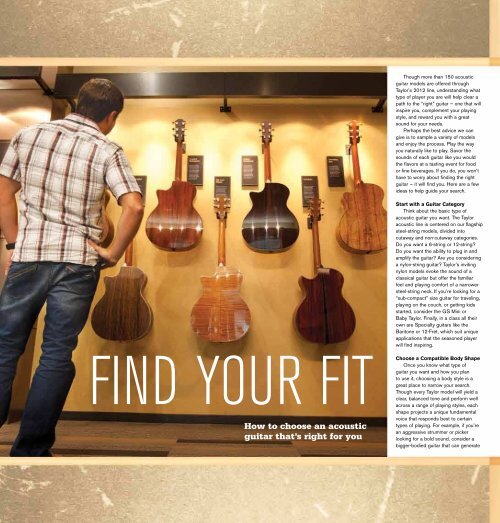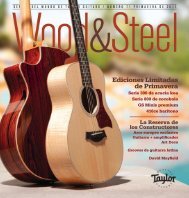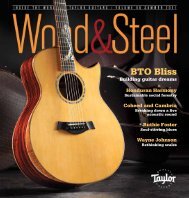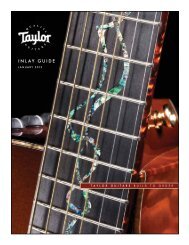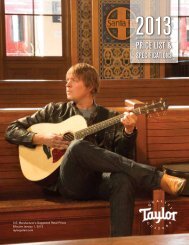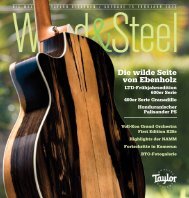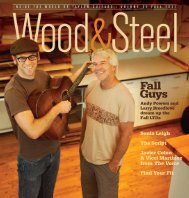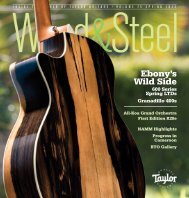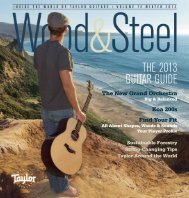The 2012 Taylor Line - Taylor Guitars
The 2012 Taylor Line - Taylor Guitars
The 2012 Taylor Line - Taylor Guitars
Create successful ePaper yourself
Turn your PDF publications into a flip-book with our unique Google optimized e-Paper software.
FiNd your FiT<br />
How to choose an acoustic<br />
guitar that’s right for you<br />
Though more than 150 acoustic<br />
guitar models are offered through<br />
<strong>Taylor</strong>’s <strong>2012</strong> line, understanding what<br />
type of player you are will help clear a<br />
path to the “right” guitar — one that will<br />
inspire you, complement your playing<br />
style, and reward you with a great<br />
sound for your needs.<br />
Perhaps the best advice we can<br />
give is to sample a variety of models<br />
and enjoy the process. Play the way<br />
you naturally like to play. Savor the<br />
sounds of each guitar like you would<br />
the flavors at a tasting event for food<br />
or fine beverages. If you do, you won’t<br />
have to worry about finding the right<br />
guitar — it will find you. Here are a few<br />
ideas to help guide your search.<br />
Start with a Guitar Category<br />
Think about the basic type of<br />
acoustic guitar you want. <strong>The</strong> <strong>Taylor</strong><br />
acoustic line is centered on our flagship<br />
steel-string models, divided into<br />
cutaway and non-cutaway categories.<br />
Do you want a 6-string or 12-string?<br />
Do you want the ability to plug in and<br />
amplify the guitar? Are you considering<br />
a nylon-string guitar? <strong>Taylor</strong>’s inviting<br />
nylon models evoke the sound of a<br />
classical guitar but offer the familiar<br />
feel and playing comfort of a narrower<br />
steel-string neck. If you’re looking for a<br />
“sub-compact” size guitar for traveling,<br />
playing on the couch, or getting kids<br />
started, consider the GS Mini or<br />
Baby <strong>Taylor</strong>. Finally, in a class all their<br />
own are Specialty guitars like the<br />
Baritone or 12-Fret, which suit unique<br />
applications that the seasoned player<br />
will find inspiring.<br />
Choose a Compatible Body Shape<br />
Once you know what type of<br />
guitar you want and how you plan<br />
to use it, choosing a body style is a<br />
great place to narrow your search.<br />
Though every <strong>Taylor</strong> model will yield a<br />
clear, balanced tone and perform well<br />
across a range of playing styles, each<br />
shape projects a unique fundamental<br />
voice that responds best to certain<br />
types of playing. For example, if you’re<br />
an aggressive strummer or picker<br />
looking for a bold sound, consider a<br />
bigger-bodied guitar that can generate<br />
more tonal output. Also, be sure to<br />
choose a body shape that’s physically<br />
comfortable to play. Here is a rundown<br />
of <strong>Taylor</strong> acoustic body shapes and<br />
their basic tone profiles:<br />
Grand Auditorium (GA)<br />
<strong>Taylor</strong>’s most versatile and popular<br />
body style finds the sweet spot<br />
between a big and small guitar. It’s<br />
robust enough to handle medium<br />
strumming and flatpicking, yet also<br />
responsive to fingerpicking. It tracks<br />
well with other instruments both in a<br />
studio mix and on stage. It’s the ultimate<br />
all-purpose guitar and has come to<br />
define the modern acoustic sound.<br />
Grand Symphony (GS)<br />
<strong>The</strong> full-bodied GS yields <strong>Taylor</strong>’s<br />
boldest, richest acoustic voice. Beyond<br />
the impressive volume and sustain,<br />
the GS is also responsive to fast<br />
picking and a bluesy fingerstyle touch.<br />
<strong>The</strong> piano-like bass, meaty midrange,<br />
and thick, shimmering highs blend<br />
seamlessly. <strong>The</strong> GS also makes an ideal<br />
choice for a 12-string.<br />
Grand Concert (GC)<br />
With its compact design, the GC<br />
is physically comfortable to play and<br />
produces a smaller sonic footprint,<br />
which helps curb the overtones and fits<br />
neatly into recording and performance<br />
scenarios. <strong>The</strong> GC gives players a<br />
“secret weapon” in the studio. It also<br />
has a shorter 24 7/8-inch scale length<br />
for easier fretting and a slightly slinkier<br />
feel, which can make a big difference.<br />
Dreadnought (DN)<br />
<strong>The</strong> <strong>Taylor</strong> Dreadnought refines a<br />
traditional guitar shape for the modern<br />
era, and players with a harder attack<br />
will love the blend of power and<br />
articulation. Because the waist is less<br />
tapered than the GS, the DN tends<br />
to concentrate the sonic horsepower<br />
slightly more in the lower register. <strong>The</strong><br />
voicing will produce driving rhythms,<br />
yield a low end that’s robust without<br />
getting muddy, and help solos cut<br />
through.<br />
Jumbo (JM)<br />
With the emergence of the GS as<br />
a big, rich acoustic voice that balances<br />
power and balance, we’ve decided to<br />
temporarily remove the Jumbo from the<br />
<strong>Taylor</strong> line for <strong>2012</strong> (with the exception<br />
of the Leo Kottke Signature Models)<br />
in order to explore voicing refinement<br />
ideas in our design studio. Look for its<br />
spirited return next year.<br />
Explore Different Tonewoods<br />
If a guitar’s shape produces the<br />
sonic equivalent of a meal, think of<br />
tonewoods as the seasoning. <strong>The</strong><br />
unique acoustic properties of woods<br />
help color a body shape’s fundamental<br />
sound. <strong>The</strong> key, once again, is to find<br />
the woods that match up best with your<br />
playing style and intended applications.<br />
It might be rosewood’s low-end growl<br />
and sizzling trebles; the midrange<br />
overtones of mahogany; the focus and<br />
projection of maple; or the warmth of a<br />
cedar top for fingerpicking. As you play,<br />
pay attention to each wood pairing’s<br />
distinctive acoustic traits, along with<br />
the feeling of responsiveness in your<br />
hands. If you plan to play and sing, tune<br />
in to the way the acoustic sound relates<br />
to your voice.<br />
Beyond tonal considerations, woods<br />
boast an inherent visual appeal that can<br />
also be deeply inspiring. Figured koa,<br />
maple, and cocobolo, to name a few,<br />
have cast a seductive spell on many a<br />
player. Grain patterns, color variegation,<br />
and other visual characteristics all help<br />
differentiate a guitar and showcase<br />
each one as a truly unique instrument.<br />
Look for more descriptions of each<br />
wood’s tonal nuances in the pages that<br />
follow, with additional details in our<br />
Woods feature at taylorguitars.com.<br />
Know Your Player Profile<br />
For all the inherent nuances of<br />
different guitars, acoustic tone is largely<br />
in the hands of the player. When <strong>Taylor</strong><br />
staff members talk to customers about<br />
choosing the right guitar at <strong>Taylor</strong> Road<br />
Shows and Find Your Fit dealer events,<br />
the first thing they do is identify the<br />
person’s “player profile.” Understanding<br />
what type of music the person likes<br />
to play and what kind of attack they<br />
have with their strumming/picking hand<br />
will help lead to the right guitar. If you<br />
own other guitars and are looking for<br />
fresh inspiration, it might be good to<br />
try a different type of guitar, as <strong>Taylor</strong>’s<br />
Aaron Dablow explains.<br />
“If a person is a bluegrass-heavy<br />
strummer and already owns a Sitka<br />
spruce/rosewood Dreadnought, I<br />
might steer them into a mahogany GS,”<br />
Dablow says. “It will give them a little<br />
extra flavor, something that will inspire<br />
them to play a little differently.”<br />
Look for Aesthetic Inspiration<br />
<strong>Taylor</strong>’s thoughtful design details<br />
make a visual impression before you<br />
ever pick up a guitar. In addition to<br />
the elegant lines that distinguish<br />
the shape of the headstock, bridge,<br />
pickguard and body, a unique package<br />
of appointments gives each guitar<br />
series a unique identity. Beautifully<br />
crafted artistic appointments include<br />
inlays, binding, and finish colors that<br />
range from subtle to sublime. <strong>The</strong><br />
visual inspiration in turn serves as an<br />
appetizer for our musical creativity.<br />
Players who crave something beyond<br />
what we offer through our standard<br />
line can design their own custom guitar<br />
through our Build to Order program.<br />
More Test-driving Tips<br />
As you evaluate guitars, try playing<br />
several models that have the same<br />
body shape but different woods. Or<br />
the same woods with different body<br />
shapes. This systematic approach will<br />
help you hone in on each guitar’s tonal<br />
differences more clearly. If you plan to<br />
record with the guitar, you might want<br />
to arrange a simple recording session<br />
to compare your leading contenders<br />
before you make your decision. If you<br />
plan to play with others, try jamming<br />
with friends in the store to gauge<br />
how the guitar will sound with other<br />
instruments.<br />
As thorough as your search may be,<br />
remember that each person’s playing<br />
and listening experience ultimately is<br />
subjective. That’s part of the beauty of<br />
finding your fit: You get to decide what<br />
inspires you most.<br />
Understanding Acoustic Model Numbers<br />
<strong>The</strong> majority of <strong>Taylor</strong>’s acoustic guitars fall into two main categories:<br />
an acoustic/electric line that comes standard with a cutaway and<br />
electronics (“ce”) and an offering of non-cutaway models. Most of the<br />
acoustic/electrics feature a three-digit model number in the 100 through<br />
900 range. Here’s how our numbering system works:<br />
814ce<br />
<strong>The</strong> first digit identifies the Series<br />
number, in this case the rosewood/<br />
spruce 800 Series. All the guitar<br />
models within each series share the<br />
same appointment package, including<br />
the rosette, binding and fretboard inlay.<br />
<strong>The</strong> third digit identifies the body shape<br />
according to this numbering system:<br />
0 = Dreadnought (DN, e.g., 810ce)<br />
2 = Grand Concert (GC, e.g., 812ce)<br />
4 = Grand Auditorium (GA, e.g., 814ce)<br />
5 = Jumbo (JM, e.g., 815ce)<br />
6 = Grand Symphony (GS, e.g., 816ce)<br />
<strong>The</strong> second digit typically indicates whether the guitar is a 6-string (1)<br />
or a 12-string (5). A 12-string Grand Symphony in the 800 Series would<br />
be an 856ce. <strong>The</strong> second digit can also be used to note a model that<br />
features the same top as the back and sides (2). For example, with the<br />
<strong>Taylor</strong> Koa Series (K), the K12ce is a six-string Grand Concert with koa<br />
back and sides and a Sitka spruce top. That same Grand Concert shape<br />
offered with a koa top would be a K22ce. If it’s a 12-string with the<br />
same top as the back and sides, 6 is used instead of 5. (A 12-string koa/<br />
spruce GS would be a K56ce; with a koa top it would be a K66ce.)<br />
For <strong>2012</strong>, our nylon-string models have been integrated into the 200-<br />
900 Series of the acoustic/electric line and are designated by the letter<br />
“N” at the end of the model name. So, a nylon-string Grand Auditorium<br />
model in the 800 Series would be an 814ce-N.<br />
<strong>The</strong> naming system for the non-cutaway acoustic line is different but<br />
related to the acoustic/electrics. Here’s how it works:<br />
GA8<br />
<strong>The</strong> model name begins with the shape abbreviation. A single digit<br />
number matches up with the woods used in the correlating series. So,<br />
the 8 here relates to the woods used for the acoustic/electric 800 Series.<br />
A 12-string version of this model would be a GA8-12.<br />
THE <strong>2012</strong> TAYLOR GUITAR GUIDE<br />
FIND YOUR FIT<br />
21


